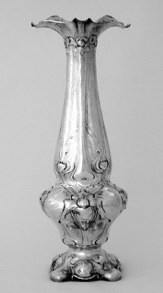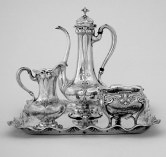Specializing in Martele silver by Gorham as well as other fine American and Continental sterling | home

Vase (1901)
Exhibited at the
Panama - Pacific Exposition
San Francisco, Ca. 1915

Black Coffee Set (1899)
Exhibited at the
Universal Exposition
Paris, France 1900
About Martele
Martele is a limited production line of fine silver that was fabricated under the direction of William Christmas Codman by the Gorham Silver Company of Providence, Rhode Island. The line began in the late 19th century, and was continued until the 1930s. Each piece is different in that they were individually designed, and then hand raised (made) and chased (decorated) which by nature produces uniqueness, where no two pieces can be the same. The hammer was the tool of manufacture, and very little machine work was utilized in the process of completing the Martele. The hammering produced a certain look, a surface that “is the soft misty finish of innumerable little hammer blows, overlapping each upon each like fairy footprints upon moonlit sands” (Stuart, 1912).
The creation of a piece of Martele was a process that included several steps. In order to keep track of each piece, all of the items were uniquely identified by a numerical or letter code, with the code indicating whether the particular item was a Sample (a piece produced by Gorham as general inventory or a salesman sample to show customers examples of completed pieces) or a Special order (a piece of Martele that was specifically designed for or ordered by a client). Those codes and production records are the basis for the Martele book.
While numerous pieces of Martele are restrained in general appearance, many of the pieces display obvious roots to the art nouveau as well as the arts and crafts movements, and become a blend of the two styles. The underlying doctrine in the development and production of Martele was to not repeat classic, historical design, but to create “new art” through the use of fluid form, with decoration to be a secondary consideration.
Martele is arguably the best silver of the 20th century, and possibly of all time, as evidenced by numerous international awards won during its heyday, when the competition and the contemporaries were the likes of Tiffany and Company in the United States, Liberty and Gilbert Marks in England, Georg Jensen in Denmark, Christofle and Puiforcat in France, and others. In an analogy for the silver collector, the production quality, special orders, and sometimes later presentations of Martele can be likened to the “Royal Silver” of the Europeans, with a large amount of Martele ownership by the American equivalence of aristocracy.
Today Gorham's Martele silver work represents one of the significant expressions of the American decorative arts. The pieces are highly collectable, and because of the variety of forms available (candlesticks, coffee items, desk items, jewelry, etc.), an example of the silver or gold work is avidly sought by collectors from many different fields.